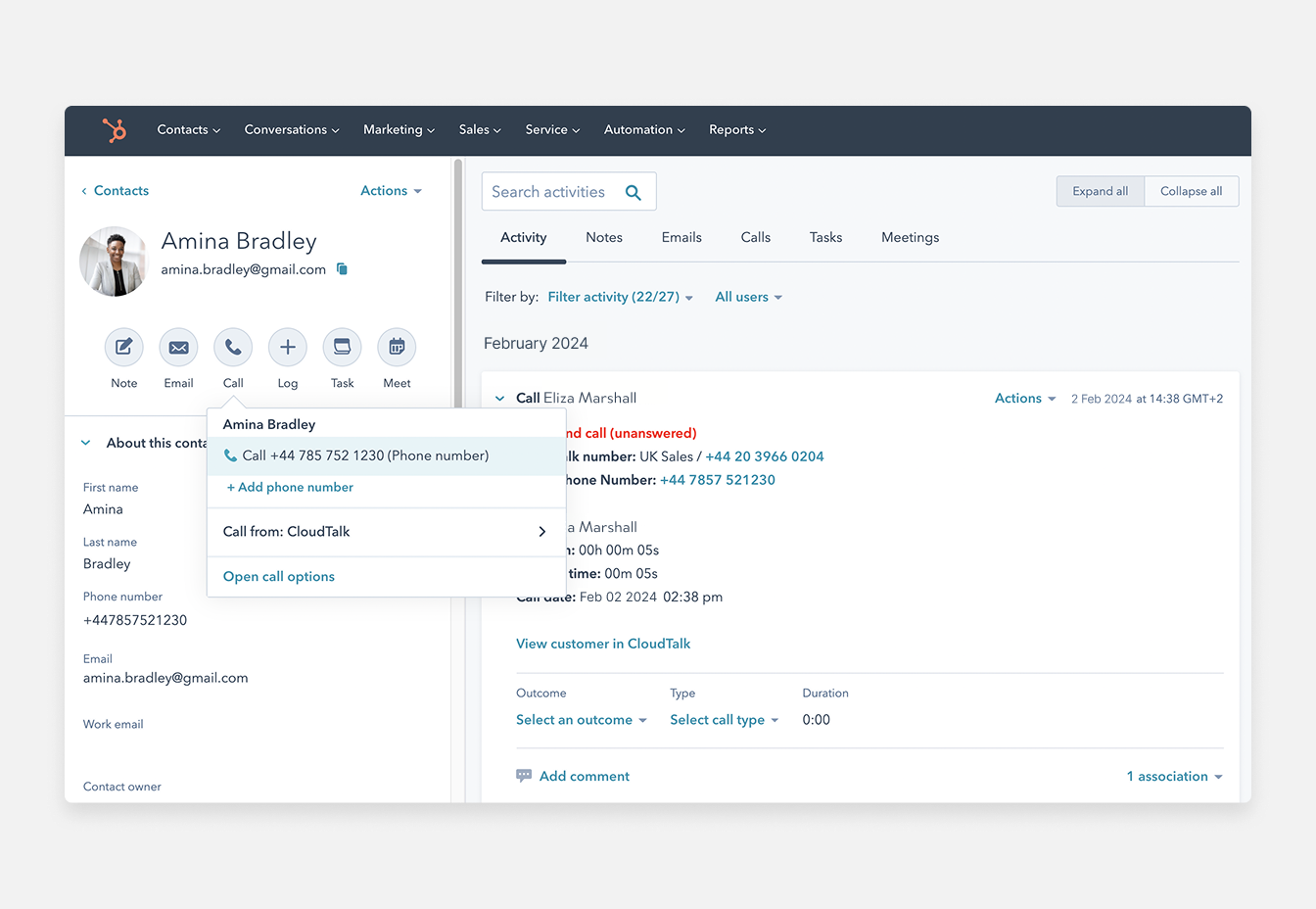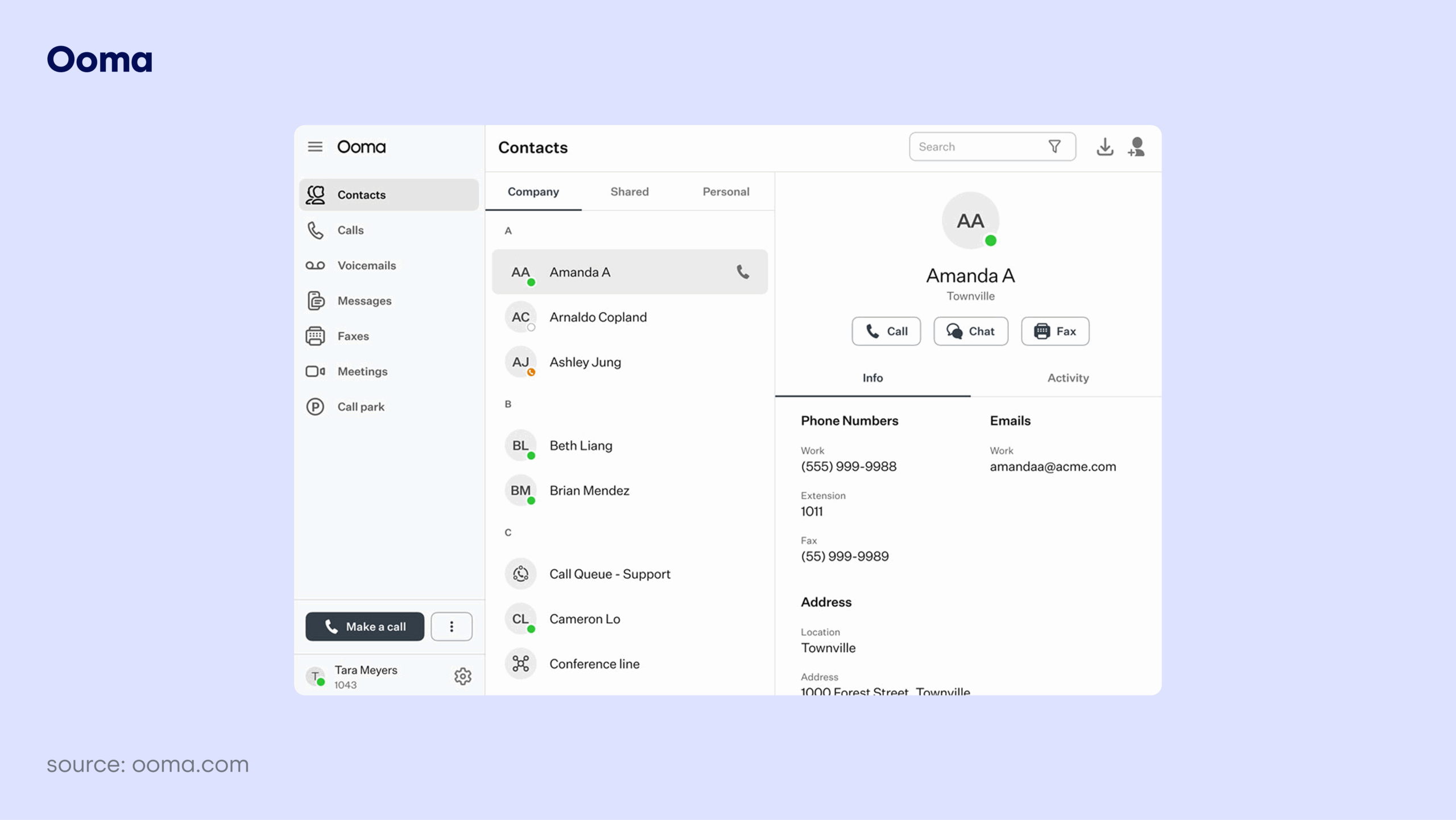TL;DR:
VoIP use has grown 212% since 2020¹ and hybrid work is now standard—so 2026 is likely the year many businesses finally leave traditional desk phones behind.
Here’s what you’ll learn in this guide:
-
Why softphones are powering SMB growth into 2026 and beyond
-
The key benefits: mobility, cost savings, simple setup, and automation
-
How softphones actually work (and why it matters for your team)
-
The best softphone providers to consider for 2026
-
What really matters when picking the right softphone for your business
By the end, you’ll know exactly why switching to a softphone is a must if you want to stay ahead.
Your team’s gone remote, your apps are all in the cloud—so why’s your business phone system still stuck in the past?
You’re not alone.
As work goes hybrid, more and more businesses are ditching desk phones for softphones: flexible, cloud-powered apps that let you talk, text, and collaborate from anywhere.
And the shift isn’t slowing down:
-
VoIP adoption has surged 212% since 2020¹
-
64% of companies now run hybrid teams²
-
55% of VoIP users rely on softphones primarily for remote/mobile work³
Why? Because softphones solve the biggest problem in business comms today: staying connected without old-school hardware, tangled cords, or missed calls.
Today, we’ll zero in on how switching to a softphone will change your small-business game in 2026—and how to pick the right one to stay ahead.
Let’s dive in.
Get a CloudTalk Demo in Minutes
Why Softphones Are a Game-Changer for Small Businesses in 2026?
TL;DR:
Softphones help SMBs simplify their phone systems, support flexible work, and cut unnecessary costs.
In this section, you’ll learn how softphones for business:
-
01
Replace physical hardware with a lightweight setup
-
02
Work from anywhere, anytime
-
03
Deliver higher call quality over the cloud
-
04
Keep a stable connection even with a stubborn bandwidth
-
05
Automate tasks using AI and virtual agents
-
06
Sync instantly with your CRM and helpdesk tools
-
07
Start running smoothly, without your devs going crazy
-
08
Scale up your team with just a few clicks
-
09
Require no manual maintenance
-
10
Offer clearer, more predictable pricing
Planning to upgrade your phone system in 2026? Softphones are flexible, cloud-based, and built for how small teams work today. There’s no need for extra hardware (alright, you might need to send your remote agents new Macs), or too much setup work.
But let’s get practical.
Here’s what makes softphones the best phone systems for growing SMBs.
1. Hardware Requirements
Hardphones mean clutter—physical desk phones, wall jacks, server closets, and tangled cords. You often need a PBX box (basically, your own mini telephone company in the office) just to manage call routing.
Softphones skip all that. Everything runs in the cloud, so there’s nothing to install or wire up. You just need a laptop, smartphone, or tablet, a decent headset, and an internet connection. That’s it. No hardware. No installer visit. No screwdriver.
2. Remote-Readiness
As you’d guess from the name, with desk phones, your work phone stays at your desk. So if you’re not in the office, you’re missing calls—or relying on clunky call-forwarding hacks.
Softphones go everywhere with you. Whether you’re at home, on the train, or halfway through a cappuccino at a café, you’re always connected. Just open the app and make or receive calls as if you were at your desk. Same number, same quality, no location restrictions.
This is why softphones are the superior choice for remote or hybrid teams.
3. Call Quality
Hardphones use analog or VoIP (Voice over Internet Protocol) desk units that rely on physical wiring and older infrastructure. That’s fine—but it’s rigid.
Softphones use something called cloud-optimized call routing. It means calls are automatically routed through the best-performing data centers at any given time. So even if one server has a hiccup, your call gets redirected on the fly—keeping the line clear and the audio sharp. You won’t even notice the switch.
Enjoy Crystal-Clear Call Quality—from Anywhere
Thanks to a global network of data centers and 99.999% uptime, CloudTalk ensures crystal-clear calls from anywhere to anywhere—whether your agents are working from a laptop in Lisbon or a mobile phone in Milwaukee. You can rely on consistent, high-quality voice performance across teams, locations, and devices.
4. Voice Stability on Low Bandwidth
Here’s where we give credit where it’s due—analog desk phones are still more stable when the internet’s acting up. No Wi-Fi? No problem for them.
But softphones have leveled up. Even if your internet connection isn’t perfect, they’re built to smooth things out.
Think of it like this—if the signal gets a bit choppy, the app fills in the gaps to keep your voice sounding normal. So, unless your Wi-Fi completely drops, your calls will still sound great. And if you’re on a solid connection? Even better—you’ll barely notice a difference from a traditional line.
5. AI & Automation
Desk phones just ring. No caller info, no context, no smart features—just a lot of manual work.
Softphones do more. The best providers now offer many AI productivity tools that streamline calling or help your new hires get up to speed. And, yes, you’ll still need real humans, AI’s just your sidekick.
Here’s what the best AI-powered softphones now offer:
-
AI Agents: Always-on assistants that handle repetitive calls.
-
Virtual Receptionists: Your 24/7 answering system.
-
AI Dialers: Smart, Power, and Parallel dialing modes to boost the outbound.
-
Conversation Intelligence: AI-driven, real-time insights for smarter calls and better agent coaching.
AI That Works With You, Not Against You
CloudTalk’s AI agents and virtual receptionists handle routine calls like lead qualification, FAQs, reminders, or follow-ups. They do that 24/7, in 60+ languages. But the best thing? They free up your team so they can focus where it counts.
Want to see what this looks like in practice? Watch the demo of CloudTalk’s AI agents in action take real customer calls, qualify leads, collect feedback, and follow up—without slowing your team down.

AI Voice Agents
Sales Reminder
Agent
Client
Sales / Marketing
Course Inquiry
Agent
Client
Education / EdTech
Payment Reminder
Agent
Client
Financial Services
Healthcare Intake
Agent
Client
Healthcare
Insurance Intake
Agent
Client
Insurance
T&C Acceptance
Agent
Client
Legal Services
Legal Intake
Agent
Client
Legal Services
Candidate Feedback
Agent
Client
Recruitment / HR
Applicant Pre-screen
Agent
Client
Recruitment / HR
Action Reminder
Agent
Client
SaaS / Software & Apps
Subscription Renewal
Agent
Client
SaaS / Software & Apps
CX Feedback
Agent
Client
SaaS / Software & Apps
Post-Sales Feedback
Agent
Client
SaaS / Software & Apps
Trial Signup
Qualifier
Client
SaaS / Software & Apps
6. CRM Integration
Desk phones live in their own little world. You take a call, hang up, and then manually enter the notes into your CRM—if you remember. Softphones work with your stack, not against it.
For example, with CloudTalk’s softphone, you get:
-
35+ native integrations with Salesforce, HubSpot, or Pipedrive.
-
Two-way, automatic sync of customer details, or real-time call tags and notes, so your reps don’t waste time on admin.
-
Open API access if you want to build your own workflows (the setup is easy, but CloudTalk is always happy to help).
You save time, your data stays cleaner, and agents don’t have to juggle five tabs while on a call.
How Talent.io Uses CloudTalk + HubSpot
Talent.io—a tech and sales recruitment platform—switched to CloudTalk after call quality and workflow issues with their previous VoIP provider. With native HubSpot integration, they now save recruiters time, keep CRM data up to date automatically, and manage candidate communication more smoothly.
7. Setup Time
Getting started with desk phones means a technician visit, wiring, hardware setup, and some mild swearing when things don’t work on the first try. With softphones, setup is a breeze.
Here’s how to install your business softphone in a few simple steps:
-
Pick your provider: We recommend CloudTalk for any SMB looking to scale.
-
Set up your account: Just sign up on the website and pick your plan—easy as that.
-
Download the app: Install on any laptop or download a mobile app.
-
Log in: Use your company email or credentials.
-
Start calling: No hardware. No waiting. Just instant business calls.
That’s how you go from “setup headache” to “up and running” in under an hour—not weeks, like with old-school hardphones.
8. Scalability
Hiring five new agents? With hardphones, that’s five new phones, five cables, five ports, and five setup headaches.
With softphones, it’s five new invites. That’s it. Need local numbers in a different country? Done in a few clicks. Want to split a support team into two regions? Create a new call flow. Everything scales without hardware or sweat.
Scale Internationally—In Just a Few Clicks
With CloudTalk, you can instantly add local numbers in 160+ countries—so you can grow into new markets and connect with customers anywhere.
9. Maintenance
Getting started with desk phones means a technician visit, wiring, hardware setup, and some mild swearing when things don’t work on the first try.
With softphones, you just log in. Really. You send an invite to a new team member, they download the app, and start calling. No SIP setups, no firewalls, no fax machines in sight.
10. Pricing
And let’s wrap the WHYs with what most of you are after—getting a reliable solution at a price that doesn’t break the bank.
How much do traditional desk phones cost?
As you’ve learned by now, hardphones are kind of old school. But that’s not the worst—they’re also quite expensive. Here’s what you’ll typically pay to get started (and keep it running):
-
Hardware: $50–$300 per desk phone
-
PBX system or VoIP gateway: $500–$2,000+ (depending on size)
-
Installation: $100–$200 per user (plus any wiring or physical setup)
-
Maintenance contracts: $200–$1,000 per year
-
Add-ons (like voicemail, call recording, or IVR): often extra
-
Support: usually billed hourly or as part of a pricey SLA
That adds up to $1,000–$3,000+ per user in year one alone. And that’s before you even make your first call.
How much do softphones typically cost?
Softphones usually follow a clear per-user pricing model—no hardware, no tech visits, no surprises. Most top-rated softphones cost $20 to $50/user/month, depending on features and plan tiers (often even less with an annual subscription).
And here’s the payoff that matters for every growing team:
According to EnterpriseAppsToday, most SMBs save up to 50% on their phone system costs after switching from old desk phones to a cloud-based softphone.⁴
Now imagine what you could do with all those savings—finally ditch old hardware for good, train your team without worrying about budgets, or just stop arguing over who gets the last decent headset.
Transparent, Growth-Friendly Pricing—No Surprises
The best softphone software, like CloudTalk, makes pricing easy to understand and easy to grow with. You get transparent per-seat pricing plans, and full access to pretty much every feature during your free trial—so you know exactly what you’re getting before you commit.
H3: Softphones vs. Hardphones: A Quick Recap
We’ve just covered why softphones make so much more sense for small businesses that want to go big in 2026. They’re flexible, scalable, and packed with the kind of smart features that desk phones just can’t keep up with.
But if you’re still wondering how softphones compare to desk phones on a feature-by-feature basis, check out this quick comparison table:
Comparison Table: Softphones vs Hardphones
| Feature | Hardphones | Softphones | Winner for SMBs |
|---|---|---|---|
| Hardware required | Yes — you need a physical desk phone, cables, maybe even a PBX | No — all you need is a laptop, mobile, or tablet, a headset, and stable internet connection | Softphone |
| Remote-ready | No — tied to your office desk and phone line | 100% — works from anywhere with an internet connection | Softphone |
| Call quality | Good — if you’re plugged in with a landline | Great — cloud-optimized routing keeps calls clear and stable | Softphone |
| Voice stability (on low bandwidth) | Strong — less impacted by spotty internet; consistent on analog lines | Good — heavily depends on internet speed and connection quality | Hardphone |
| AI & automation | None — zero automation, zero AI insight | High — AI agents, auto-dialers, and virtual receptionists handle routine calls and speed up workflows | Softphone |
| CRM integration | Rare — and usually needs expensive hardware upgrades | Built-in — automatically logs calls, notes, and tags to tools like Salesforce and HubSpot | Softphone |
| Setup time | Slow — tech visits, wires, manual configs | Fast — download the app, log in, start calling the same day | Softphone |
| Scalability | Limited — adding lines takes time, hardware, and money | Instant — add users, numbers, or teams in a few clicks | Softphone |
| Maintenance | High — requires repairs, upgrades, and onsite support | Low — updates happen automatically in the cloud | Softphone |
| Costs | High — hardware, service contracts, plus surprise support costs | Transparent — per-user pricing, no special hardware, and free trial options | Softphone |
So which is better—softphone or hardphone?
Unless you’re nostalgic for landlines and tangled cords, VoIP softphones win in every category that matters to a modern small business. They’re lighter, faster, cheaper, and smarter. No contest.
Wi-Fi Woes? Not a Dealbreaker.
Softphones work best with stable internet, but modern tools like CloudTalk use adaptive routing and fallback options to maintain high-quality calls—even on spotty connections. So even this one ‘hardphone win’ isn’t as clear-cut as it seems.
How We Chose the Best Softphone Applications for SMBs
When choosing the best softphone providers, we focused on whether these tools actually deliver what softphones promise—and what truly makes them a better choice than outdated, on-prem phone systems.
Every tool on our list had to:
-
Replace old hardware and work anywhere, so teams aren’t stuck at their desks
-
Deliver clear, reliable calls—even if your internet isn’t perfect
-
Automate the routine calls with AI features
-
Sync everything with your CRM or helpdesk to cut manual admin
-
Scale fast and onboard new users with just a few clicks (no tech headaches)
-
Keep costs predictable, with simple per-user pricing and no surprise fees
And from 20+ apps we’ve tested, we cherry-picked 5 top softphones that any small-to-medium businesses looking to upgrade their phone system should consider. Read on and learn why.
Why Trust Our Reviews?
For nearly a decade, we’ve helped over 30,000 professionals choose the best cloud communication tools for their business.
We’ve tested more than 200 products, analyzed 5,500+ verified reviews, and cross-referenced insights from real user discussions on platforms like Reddit, Quora, and TrustRadius.
Every CloudTalk software review follows the same methodology—human-written, data-backed, and focused on real usability, not marketing spin.
Learn how we keep our content integrity and our software review methodology.
Explore More Expert Reviews
H2: Best Softphones for Small Business Aiming to Scale Effortlessly in 2026
TL;DR:
Here are the top 5 softphones for SMBs looking to grow in 2026 and beyond:
-
CloudTalk — Best AI-powered softphone for teams that want automation and deep CRM sync
-
RingCentral — Best unified workspace for voice, video, and messaging
-
3CX — Best for IT-managed teams who need full PBX control
-
Dialpad — Best AI coaching and analytics for hybrid teams
-
Ooma Office — Best for small teams needing simple, budget-friendly VoIP
Finding the right softphone for your business is all about matching your real needs: fast onboarding, reliable calling, easy integration, and flexible scaling—no matter where your team works.
Here’s a quick look at how the top options stack up:
Comparison Table: Best VoIP Softphone Providers
| Softphone App | Best for | Pricing (annual) | Free Trial |
|---|---|---|---|
| CloudTalk | Scaling SMBs that need AI-powered automation, CRM integration | From $19/user/month (Lite) + pay-as-you-go AI agent calls | Yes — 14 days |
| RingCentral | Unified comms (voice, video, chat) | From $30/user/month | Yes — 14 days |
| 3CX | IT-managed PBX and SIP | From $18/user/month | Yes — Limited |
| Dialpad | AI coaching, hybrid teams | From $23/user/month | Yes — 14 days |
| Ooma Office | Simple, budget softphone | From $20/user/month | Yes — 30 days |
Now, let’s break down why each tool made the list—starting with the best fit for SMBs that want to scale smarter.
CloudTalk — Best AI-Powered Business Softphone for Scaling SMBs
CloudTalk is the best AI-powered softphone solution for scaling SMBs that want to streamline their calling by automating routine calls with AI, connecting their CRMs, and tracking performance in real time—without extra hardware or setup headaches. At the same time, it lets you enjoy enterprise-grade call quality in 160+ countries.
These are the main reasons why CloudTalk is an ideal softphone application for growing sales, support, ops, or HR teams that rely heavily on phone conversations.
Check out CloudTalk’s business softphone solution in the quick interactive demo below:
A quick overview of CloudTalk softphone:
-
Best for: SMBs needing a full-featured softphone with AI automation, analytics, and native integrations
-
Starting price: From $19/user/month (Lite) + $0.25/minute for voice AI calling
-
Free trial: CloudTalk offers a 14-day free trial, letting you get your hands on all of its softphone features
-
G2 rating: 4.4/5 (1,600+ reviews)
Best features:
-
Integrations & Compatibility: 35+ native integrations with Salesforce, HubSpot, Zendesk, and Intercom, plus API access for custom CRMs. Works on macOS, Windows, iOS, and Android.
-
Ease of Setup: Forget about manual SIP (Session Initiation Protocol) setups or IT requests. With auto-provisioning, your agents can start calling within minutes—everything’s configured for them automatically.
-
Security & Compliance: Every call is protected by TLS and SRTP encryption, plus role-based access controls—so your customer data stays private and compliant at all times.
-
Support & Reliability: You get 24/7 live chat and onboarding support, backed by a 99.999% uptime SLA—so your phone system is always ready when you need it.
-
Customization & Collaboration: Need flexibility? Tag calls, add notes, and transfer conversations internally to keep your whole team in sync, wherever they work.
-
Scalability: Expanding your team? Add or remove seats and virtual softphone numbers anytime, and route calls across 160+ countries for a truly global presence.
-
AI-Enhanced Automation: Save time by automating routine calls with AI agents, virtual receptionists, and AI dialers, supported by AI-driven analytics, conversation insights, and programmable call flows—or connect third-party bots via API for a fully autonomous setup.
-
Real-Time Analytics: Track performance as it happens. From call quality to agent KPIs, everything lives in one dashboard so you can spot issues and optimize on the go.
Pro Tip: Notice a Pattern?
Go on—scroll back up to the ‘Why Softphones Are a Game-Changer’’ section for a second. See how CloudTalk’s key features line up almost one-to-one with how softphones change the calling game? That’s not by accident. It’s built to check every box growing teams actually care about—security, setup, scalability, integrations, and insight.
Where it stands out:
CloudTalk’s softphone application turns your calling setup into a true business advantage. You can sync your favorite apps, onboard teams faster, and automate the repetitive tasks so your people spend less time managing calls and more time talking to customers.
Let’s see what real small-business reps are saying:
”CloudTalk has been a game-changer for our business! The platform is incredibly user-friendly, and setting up our phone system was quick and painless. Call quality is consistently clear, and features like call routing, call recording, AI, and analytics have made it much easier for our team to stay productive and provide excellent customer service.”
”CloudTalk has become an integral part of our daily operations, especially because we handle a high volume of customer service and support calls. The platform is extremely reliable—we rarely experience call drops or latency issues. The call quality is consistently excellent, even during peak hours. One of the most beneficial features is the Analytics Dashboard, which provides detailed insights into call duration, agent performance, and customer engagement metrics.”
And it’s not just individual users seeing results. CloudTalk is helping fast-moving sales teams streamline operations at scale.
Just look at Zaren—a high-growth organization that consolidated six disconnected phone systems into one unified CloudTalk platform, now powering 80–100 tracked calls per agent per day across three countries.
Get the Same Results as Zaren
RingCentral — Best UCaaS Softphone for Unified Communication
RingCentral is a leading UCaaS platform (Unified Communications as a Service) that merges voice, video, and team messaging into one workspace. It’s built for fast-scaling teams that want a fully unified communication system with robust admin control and global reliability.
A quick overview of RingCentral:
-
Best for: Teams needing unified voice, video, and team chat
-
Starting price: From $30/user/month
-
Free trial: RingCentral offers a 14-day free trial
-
G2 rating: 4.3/5 (2,700+ reviews)
Best features:
-
Unified workspace for calls, video, and chat
-
Enterprise-grade compliance (HIPAA, GDPR, SOC 2)
-
Integrations with Salesforce, Microsoft 365, and Slack
-
Global voice coverage across 45+ countries
-
Advanced admin controls and analytics
Where it stands out:
RingCentral’s UCaaS model makes it ideal for small businesses to enterprise teams running multiple communication channels under one roof. It delivers rock-solid security and reliability with deep collaboration tools for large distributed teams.
Let’s see what real users are saying:
“The ease of use and rapid implementation were impressive, allowing our employees to adapt quickly with minimal training. The platform offers many features, including video, voice, messaging, and integration capabilities.”
RingCentral vs. CloudTalk
RingCentral offers a strong all-in-one suite, but it’s built for small teams expanding to the enterprise level. CloudTalk delivers the same high-quality calling, analytics, and integrations—without the heavy setup or enterprise pricing—making it a better fit for growing SMBs.
3CX — Best Softphone for IT-Managed Teams That Need Full Control
3CX is a PBX (Private Branch Exchange) system that gives small businesses full control over their VoIP setup. Even though it leans more toward a traditional setup, you can host it in the cloud. This makes it a good fit for IT-led teams that prefer owning and managing every part of their phone infrastructure.
A quick overview of 3CX:
-
Best for: IT-managed teams requiring self-hosting or SIP trunking (Session Initiation Protocol)
-
Starting price: From $18/user/month
-
Free trial: 3CX offers a limited free trial period
-
G2 rating: 4.4/5 (500+ reviews)
Best features:
-
Self-hosted or cloud-hosted PBX flexibility
-
Advanced SIP trunking and call routing options
-
Built-in web client and mobile apps
-
Customizable IVR and call queue setup
-
Full control over call data and security
Where it stands out:
3CX gives companies complete control and technical freedom—it’s a perfect choice for businesses with in-house IT teams that enjoy full customization and want to host their own PBX.
Let’s see what real users are saying:
“As the administrator of our 3CX system, I find the implementation and configuration process to be very straightforward and easy to follow. Setting it up does not take much time, allowing you to get started quickly. I appreciate the availability of a cloud option, which eliminates the need for on-premise hardware.”
3CX vs. CloudTalk
3CX gives SMBs hands-on control, but that comes with maintenance, manual updates, and higher setup complexity. CloudTalk provides the same call quality and flexibility—without the technical overhead—so you can focus on customers, not configurations.
Dialpad — Best Softphone for Hybrid Teams That Want AI Coaching
Dialpad is an ideal softphone for hybrid and remote teams that need AI insights for targeted coaching. It uses built-in speech recognition and machine learning to deliver live call transcription, automated summaries, and contextual insights—all in a clean, modern interface.
A quick overview of Dialpad:
-
Best for: Hybrid teams and startups that want to coach agents in a modern way
-
Starting price: From $23/user/month
-
Free trial: Dialpad offers a 14-day free trial
-
G2 rating: 4.4/5 (4,300+ reviews)
Best features:
-
AI coaching insights for agents and sales teams
-
Real-time transcription and smart summaries
-
Integrations with HubSpot, Google Workspace, and Salesforce
-
Cross-device compatibility for remote work
-
Built-in chat and meeting tools
Where it stands out:
Dialpad is a modern, easy-to-use softphone with strong AI transcription tools and productivity features—ideal for smaller teams that work in hybrid or fully remote setups.
Let’s see what real users are saying:
“Dialpad Connect is super easy to use and keeps everything in one place—calls, video, messaging, even SMS. I love that I can switch between devices seamlessly and stay connected no matter where I am, which is huge for a team spread across multiple locations.”
Dialpad vs. CloudTalk
Dialpad’s AI helps you understand calls, but only after they happen. CloudTalk’s AI goes further—handling routine calls, routing, and analytics automatically. For teams ready to scale beyond transcripts, CloudTalk brings true AI-driven efficiency, even at scale.
Ooma Office — Best Budget Softphone for Small Teams
Ooma Office is a budget-friendly softphone solution for small businesses that want plug-and-play simplicity. It’s easy to install, reliable, and inexpensive—perfect for teams that just need a professional phone system to get started.
A quick overview of Ooma Office:
-
Best for: Small offices and solo operators needing a cheap and simple softphone
-
Starting price: From $20/user/month
-
Free trial: Ooma offers a 30-day free trial
-
G2 rating: 4.6/5 (100+ reviews)
Best features:
-
Simple plug-and-play setup for non-technical teams
-
AI phone answering and call forwarding options
-
Mobile and desktop apps
-
Voicemail, call transfer, and basic analytics
-
Flat-rate plans with no hidden fees
Where it stands out:
Ooma offers the simplest setup in the group—it’s designed for small teams that just need to get up and running fast with no technical support required.
Let’s see what real users are saying:
Ooma vs. CloudTalk
Ooma makes calling affordable and easy, especially for tiny offices—but it stops there. CloudTalk starts at a similar price tag, but it builds on Ooma’s simplicity with advanced routing, AI automation, and CRM integrations—helping your phone system grow as your business does.
H2: What Is a Softphone for Business?
Imagine a phone system that travels with you. A softphone is software that runs on a computer or smartphone to make and receive calls over the internet. You get a virtual number, audio and video calling, and the same business tools as a traditional PBX—without the hardware.
Here’s how it works:
-
01
Your voice is converted into digital signals and transmitted through your VoIP provider’s servers.
-
02
The receiver’s softphone decodes it instantly, resulting in clear, low-latency audio.
-
03
Every call, voicemail, and message is logged in the cloud—often auto-synced to your CRM.
Softphones do more than let you work from anywhere. Since calls happen in the cloud, you can easily keep track of every conversation, get automatic notes, and see what’s working—so you can help your team do better, faster.
CloudTalk Lets You Save Even More
With CloudTalk’s Conversation Intelligence add-on, which comes at a mere $9/user/month, you unlock serious productivity gains. Features like Smart Notes save agents an average of 57 minutes per day by automating post-call summaries. That adds up to $3,573 in annual savings per agent—all from eliminating manual note-taking.
How Do Softphones Work for Business Use?
Softphones use VoIP (Voice over Internet Protocol) to send your voice over the internet instead of through physical phone lines. It’s kind of like how email replaced faxes—faster, cheaper, and way more flexible.
Here’s how softphones work in simple terms:
-
You speak into your device (desktop, laptop, or smartphone).
-
Your softphone app turns your voice into digital packets.
-
Those packets travel through your VoIP provider’s cloud servers.
-
On the other end, the softphone converts them back into audio.
That’s it. You’re talking in real time—minus the bulky hardware, the tangled cords, or the IT guy crawling under your desk.
Softphones also keep everything logged in one place: missed calls, recordings, voicemails, tags, and even real-time call notes.
And the leading business softphones like CloudTalk also connect to your CRM or helpdesk tools so your agents don’t waste time copying things over or switching tabs.
How to Choose Your Softphone and What to Look For
By now, you know that switching to a softphone is the best way to keep your business moving and your team ahead of the curve. But with so many choices, how do you make sure you pick the right one?
So, before you commit, ask yourself these key questions:
-
Will this softphone actually get calls to the right person—every time?A good softphone routes the calls that need it to the right person or team, so customers aren’t left waiting or bounced around. This means happier customers, fewer missed opportunities, and less stress for your staff.
-
Does this softphone help my team respond faster to voicemails?Voicemail transcription turns every voice message into a quick, readable text. Your team can instantly see what’s urgent, follow up faster, and never let an important call slip by—even during your busiest days.
-
Can I easily review calls if I need to check the details or train someone new?Call recording and playback in your softphone let you revisit any conversation for coaching, quality assurance, or resolving disputes. It’s your safety net and your training tool, all in one.
-
Is this softphone built to work with my CRM and helpdesk tools?The right softphone integrates with your CRM or helpdesk tools, automatically logging calls and notes so your records are always up to date. No manual data entry means more time for real work.
-
Will my softphone show me more than just a phone number when someone calls?Once your stack is synced, your softphone pulls caller details straight from your tools. Your agents can greet customers by name and pick up conversations where they left off—building trust and saving time.
-
Will I have real-time insight into how calls are going?Real-time dashboards and analytics let you see what’s happening with your calls right now. Spot issues early, see which agents need support, and make smarter staffing decisions on the fly.
-
Does the softphone handle routine work automatically—so my team can focus on real conversations?AI agents and smart sales dialers take repetitive work off your plate, from handling routine calls to automating the outbound. Your team spends less time on admin, and more time actually helping customers.
-
Will this softphone let me work on any device, anywhere?The best softphones are remote-ready, letting you and your team make and receive calls on your laptop, phone, or tablet—whether you’re at your desk or on the go.
-
Can my team easily share updates, voicemails, and notes—without endless emails?Collaboration is built in, so your team can instantly share important info with each other, speed up follow-ups, and keep everyone in the loop.
-
And will I have control over who can access sensitive info?Role-based access puts you in charge of who sees or changes business-critical data, helping you stay secure as you grow.
If every answer is “yes,” you’ve found a VoIP softphone that will take your calls to the next level in 2026 (and future-proof your business far beyond).
Take Your Calls (and Growth) to the Next Level
Recommended Articles
Conclusion: Why Softphones Are a Must-Have for Growing SMBs in 2025
Softphones are quickly changing how small businesses communicate and grow. With the right platform, you get reliable calls, easier teamwork, simple setup, and real savings—no matter where your team works.
Here’s what softphones deliver right away:
-
No hardware headaches—just log in and work from anywhere
-
Clear, reliable calls, even on spotty connections
-
AI and automation to handle repetitive tasks
-
Seamless CRM and helpdesk integration
-
Instant onboarding and easy scaling
-
Simple, predictable pricing
-
No manual maintenance or IT bottlenecks
And the ROI speaks for itself.
82% of companies save money when they switch to softphone calls, and most SMBs see their phone bills drop by about 50%—and some even as much as a whopping 90%!⁴ If you’re watching your budget, those kinds of savings are a total game-changer.
Ready to ditch the old setup and scale in 2026? CloudTalk’s business softphone has you covered. It checks every box—so your team can grow, streamline ops, make calls smarter, and stay focused on customers, not tech hassles.

Ready to Grow Smarter?

Sources:
-
01
Tech.co
-
02
ElectroIQ
-
03
Zipdo
-
04
EnterpriseAppsToday

































